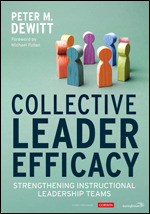Strengthen Instructional Leadership Teams
Collective Leader Efficacy: Strengthening Instructional Leadership Teams
By Peter M. DeWitt
(Corwin, 2022 – Learn more)
Reviewed by Brian Taylor

Whether the mandates come from COVID protocols or curriculum changes to support standardized testing, educators at all levels feel we have lost control over the best way to educate our students.
In Collective Leader Efficacy, Peter DeWitt has given us the antidote to that helplessness.
While the book is written from the perspective of improving teaching and learning at the building level by implementing change through instructional leadership teams, its lessons can be applied at the district office level as well.
Finding ways to do this vital work
DeWitt, a former principal and long-time columnist for Education Week, begins the book by reminding us that we cannot abandon the work we were doing before the pandemic, nor can we ignore the many positive changes that were implemented during the pandemic. It is the instructional leadership team that must do this vital work.

I think the two key terms in that statement are leadership and interdependence. Leadership for systemic change cannot just come from the individuals with titles in the district. Real change must come from the teachers in the classroom. For that to occur, those with titles must be willing to give away some of their power to move student learning forward.
Many of us become so focused on teaching that we forget that we must also be learners. Our system is broken and only works for some students. The only way to fix that is to stop believing that we have all the answers and start asking questions.
DeWitt writes: “[M]embers of the ILT need to develop a learner’s mindset so they can center into classrooms and school-based decisions with curiosity and a leadership mindset so they can step up and lead through the learning they do” (p. 27).
As leaders we need to model this learner’s mindset. We need to take risks and let our staff know that it is not only okay but expected that they do so as well. These risks are necessary because the pandemic is only one issue that we are all facing. We also must navigate political, racial, and social issues. Those problems will only be solved if we are willing to take risks and buck the status quo.
Dealing with an initiative that isn’t working
Sometimes the most significant risk is not adding something new but taking something away. Everyone in education, at one time or another, has felt initiative fatigue. Subtracting an initiative that is not working can have a more significant impact than adding something new.
When we decide to de-implement something, we take away a program that people are emotionally invested in, even if it is not working. You will inevitably hear the cries that you are not being supportive. “There needs to be a balance here by feeling that we are supported but also understanding that support is a two-way street: we need to also be supportive of our school districts” (p. 69). Whether adding or subtracting a program, we need to understand our overall goals and how the program fits into those goals.
No matter what is decided, we all must figure out how we fit into the changes. Rather than seeing the changes as something done to us, we need to figure out how we fit into the changes. Leaders need to take a step back and realize that they cannot be the center of the initiative, nor should they be.
Empowering educators
Leaders, formal and informal, need to provide learning opportunities and ongoing support. Teachers may need help to figure out where they fit into the changes being made. They will also need to feel they have some control over what will happen in their classrooms. “[S]chool leaders need to know the difference between when to speak and when to listen, when to control, and when to give up control” (p. 116).
Our job, as leaders, is to empower educators, not enable them to continue using ineffective practices that do not foster student learning. We empower educators by providing professional learning experiences they can design and implement. These learning experiences need to support the overall mission. To do that, we must open our minds. “’I find that one of the best, but most difficult ways for me to learn is to drop my own defensiveness, at least temporarily’” (Rogers, 1954, p. 149).
The best way to drop your defensiveness is to ask questions. You may disagree with everything being said or implemented, but if you ask questions, you can open your mind to new possibilities that you have yet to think about. The only way to do that is to listen for understanding, not listen to respond.
Centering on students
Everyone on the team must be worried about all students. It goes beyond your favorite lesson. It goes beyond that pet project. “’The purpose of strengthening the instructional core is not about individual preferences; it is about contributing to the greater good of the school’” (Hargreaves and Shirley, 2012, p. 164).
Often resistance to change has nothing to do with the idea but with the fact that the person implementing the change does not believe they can do it successfully. It is our role as leaders to help them build the confidence to not only implement the change but to implement it well. We can only do that if we have credibility as instructional leaders.
We must acknowledge that adult issues in school are important but should not be the focus of change initiatives. The chief issue is deciding what all our students need to succeed. Ask any student in any school, and they will be able to tell you which teachers will help them succeed. They know which teachers give them meaningful experiences and which are just packing their brains with meaningless facts. “The issue here is that student engagement is too often focused on what the adult in the room wants and not necessarily on what the student deems important” (p. 197).
DeWitt challenges us to be better
Collective Leader Efficacy has challenged my assumptions about school reform and reaffirmed many of my core beliefs. We cannot throw out the baby with the bathwater, but we cannot continue to subject students to practices that are clearly not working.
Moving forward will be a team effort. If we, as educators, want to influence how education moves forward in this country, we need to do it systematically. Here’s Dewitt’s powerful summation: “’Bottom line: If educators want to exercise political influence in the reconstitution of leadership, they will have to begin to act more like professionals’” (Elmore, 2006, p. 188).
Brian Taylor (@WIExecDirHR) is the Executive Director of Human Resources in the West Islip Union Free School District. He has been in West Islip for eight years, previously as Director of Science and Engineering Technology. This year marks his twenty-second year in education. He writes a weekly blog called the Educational Stoic.






























